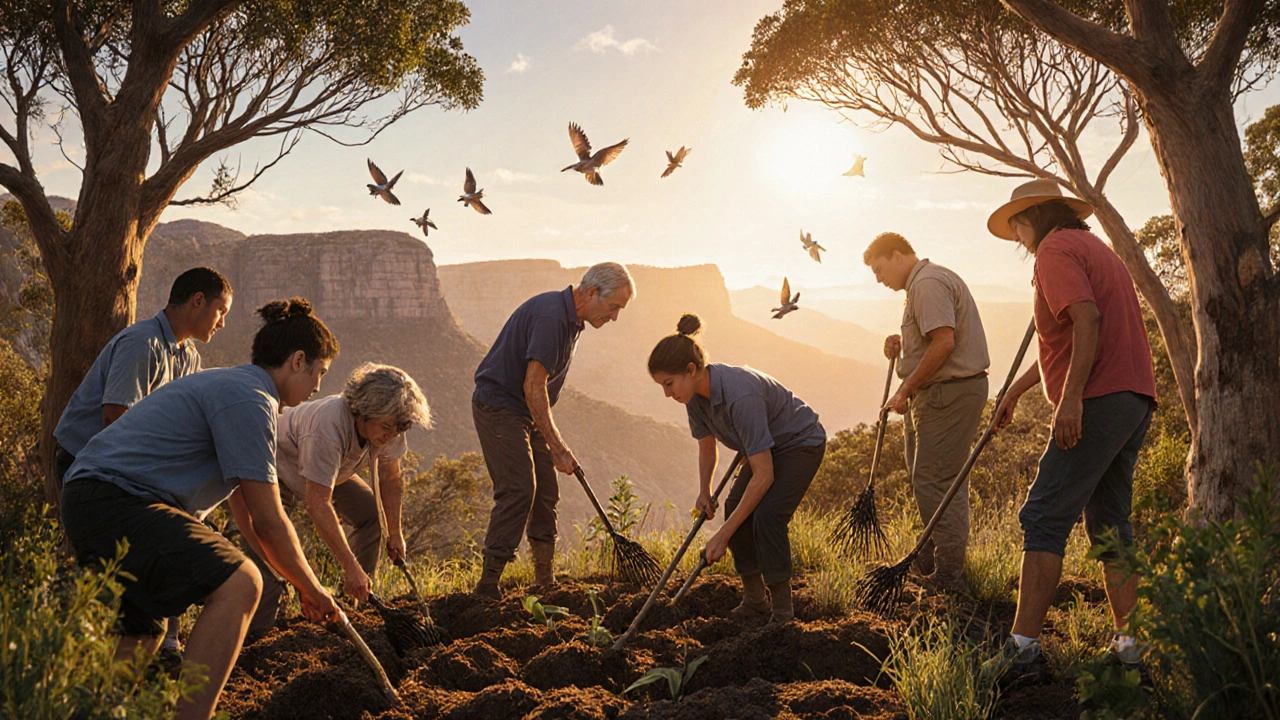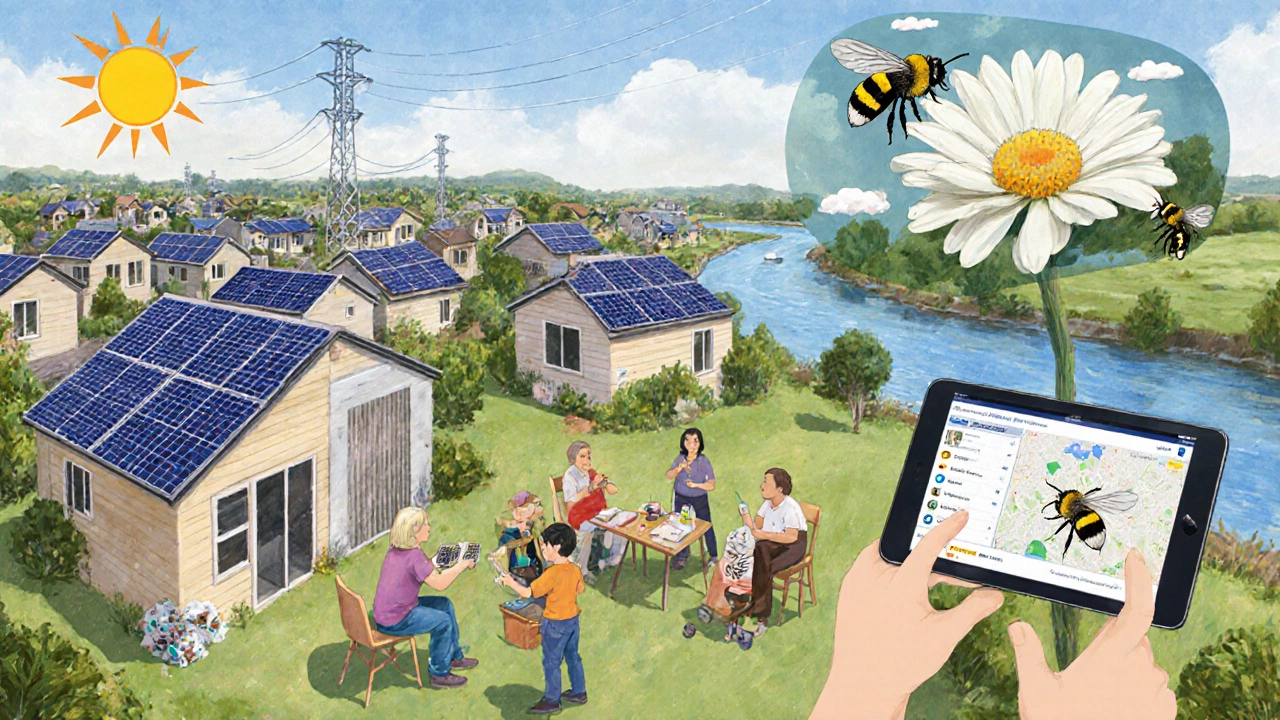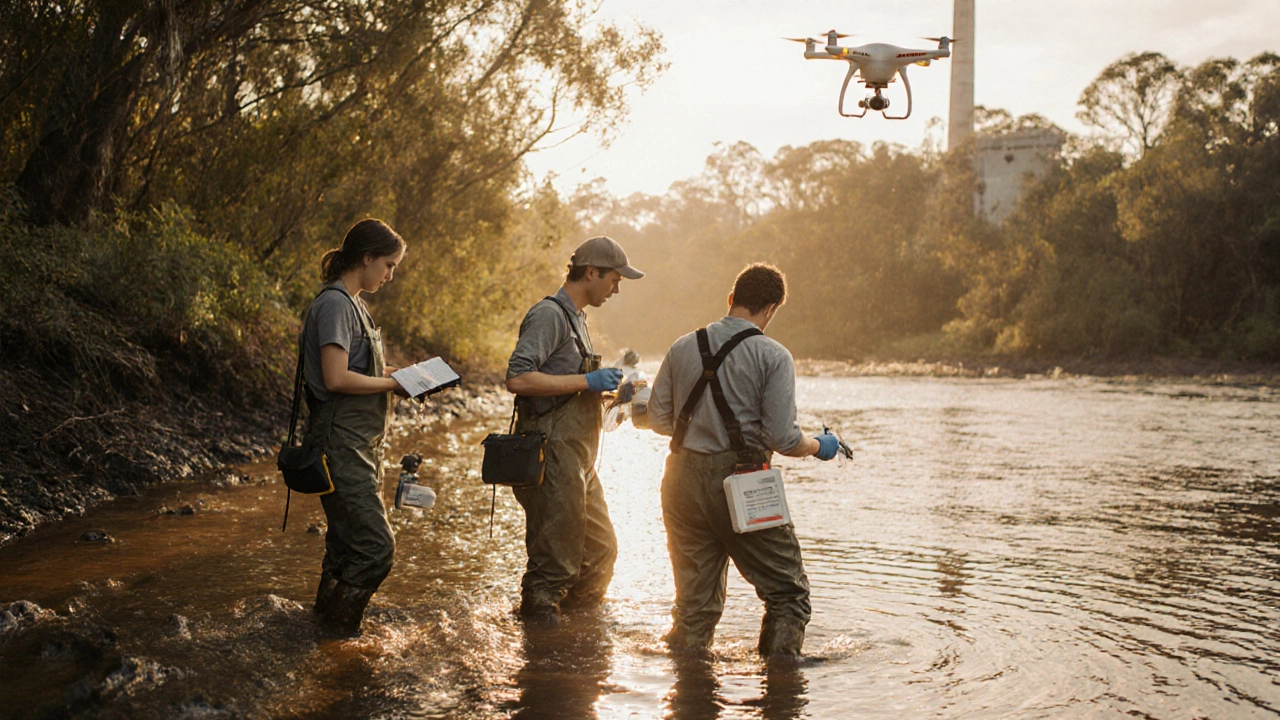Environmental Impact Calculator
- Similar to the 18% energy reduction achieved by Melbourne school students
- Equivalent to 40% increase in native birds from Blue Mountains tree planting
- Matches the 25 tons of food waste processed by Adelaide composting hubs
Environmental groups don’t just hold signs and post on social media. They’re on the front lines of change-working in forests, courts, classrooms, and city halls. If you’ve ever wondered what these organizations actually do beyond protests, the answer is a lot more practical, powerful, and varied than most people realize.
They push for stronger laws and hold polluters accountable
Environmental groups spend years tracking violations, gathering evidence, and filing lawsuits when companies break environmental rules. In 2023, a coalition of Australian groups successfully sued a mining company for illegally dumping toxic waste into a river in Queensland. The court ordered cleanup costs of over $18 million and banned the company from operating in sensitive zones for five years. That didn’t happen by accident. It took field scientists collecting water samples, lawyers specializing in environmental law, and volunteers documenting illegal dumping with drones.These groups also lobby for new legislation. In New South Wales, local environmental networks helped draft and pass the Environment Protection Amendment Act 2024, which required industries to report real-time emissions data. That kind of law doesn’t appear out of nowhere. It comes from hundreds of public submissions, expert testimony, and pressure from organized communities.
They restore ecosystems one project at a time
While politicians debate policies, environmental groups get their hands dirty. In the Blue Mountains, volunteers from the Greater Sydney Landcare Network planted over 120,000 native trees and shrubs between 2022 and 2025. They didn’t just plant them-they monitored survival rates, removed invasive weeds, and trained locals to maintain the sites. The result? A 40% increase in native bird populations in those areas.Coastal groups are doing the same with mangroves and seagrass. In the Hunter Region, a group called Marine Guardians removed 17 tons of plastic from estuaries and reintroduced 3,000 square meters of seagrass. That’s not just a feel-good project. Seagrass absorbs carbon 35 times faster than rainforests and protects shorelines from erosion. These groups turn science into action-and they do it with mostly volunteer labor.
They educate communities and shift public behavior
You can’t fix environmental problems if people don’t understand them. That’s why environmental groups run school programs, public workshops, and community campaigns. In Melbourne, the Climate Action Network trained over 2,500 high school students to conduct home energy audits. Students went door-to-door with simple tools-thermometers, power meters, and checklists-and helped families cut their energy use by an average of 18%.These aren’t one-off events. Groups like Greening the Desert in Western Australia teach drought-resistant gardening to homeowners and farmers. They’ve helped over 8,000 households replace lawns with native plants, saving millions of liters of water each year. Education isn’t about guilt-it’s about giving people tools they can use right away.
They support Indigenous land management
One of the most effective conservation strategies in Australia is partnering with First Nations communities. Environmental groups don’t lead these efforts-they follow. In the Northern Territory, the Arnhem Land Fire Abatement Project brings together Indigenous rangers and environmental NGOs to use traditional fire management. These controlled burns reduce the intensity of wildfires, protect wildlife habitats, and cut carbon emissions by up to 60% compared to unmanaged bushfires.Groups like the North Australian Indigenous Land and Sea Management Alliance (NAILSMA) help secure funding, provide equipment, and document outcomes. But the knowledge, leadership, and cultural authority come from the Traditional Owners. These partnerships aren’t charity. They’re recognition that Indigenous land stewardship has kept ecosystems healthy for over 60,000 years.

They build local networks that outlast political cycles
When governments change, policies can flip. But community-based environmental groups keep working. In Tasmania, the Huon Valley Environmental Group has been active for over 30 years. They’ve fought logging, protected rivers, and created community gardens-all while maintaining a core team of 15 dedicated volunteers and hundreds of occasional helpers.These groups create lasting infrastructure: seed banks, tool libraries, recycling drop-offs, and citizen science monitoring programs. One group in Adelaide started a community composting hub that now processes 25 tons of food waste annually and supplies free compost to 200 local gardens. That’s a system that doesn’t rely on government funding. It relies on neighbors helping neighbors.
They use technology to amplify impact
Modern environmental groups aren’t stuck in the past. They use satellite imagery to track deforestation, apps to report illegal dumping, and AI to predict pollution hotspots. The Australian Marine Conservation Society uses drone footage to monitor coral bleaching across 200 reef sites. Their data feeds into national reports used by the Department of Climate Change.Other groups use open-source mapping tools to show where plastic waste accumulates in rivers. In Brisbane, a group called RiverWatch mapped over 1,200 litter hotspots and shared the data with local councils. Within a year, 14 councils added more bins and increased clean-up patrols. Technology turns observations into action.
They make the invisible visible
Many environmental harms are hidden. Chemical runoff, noise pollution, light pollution-they don’t always show up in news headlines. Environmental groups spend years measuring what others ignore. In Sydney, a group called Dark Sky NSW measured skyglow across suburbs and found that 87% of residential areas had light pollution levels exceeding international safety standards. Their report led to new outdoor lighting regulations in five councils.Another group, Silent Rivers, recorded underwater noise from shipping and construction in Port Jackson. They found that dolphin communication was being disrupted by frequencies that matched industrial activity. Their findings prompted a temporary ban on pile-driving during breeding season. These groups don’t wait for disasters. They catch problems before they explode.

They create alternatives to harmful systems
Sometimes the best way to fight a problem is to replace it. Environmental groups are building new models: community-owned solar farms, zero-waste stores, repair cafés, and car-sharing collectives. In Geelong, a group called Local Power launched a community-owned solar project that now powers 400 homes. Residents buy shares and get reduced electricity rates. The project turned $1.2 million in community investment into clean energy-and kept profits local.Similar groups run repair workshops where people bring broken appliances and learn to fix them. One in Canberra has saved over 8,000 items from landfills since 2020. These aren’t niche experiments. They’re scalable solutions that prove you don’t need corporations to solve environmental problems.
They make it personal
The biggest myth about environmental groups is that they’re distant or impersonal. They’re not. They’re made up of teachers, nurses, retirees, students, and parents. They’re the person who shows up every Saturday to clean a creek. The one who writes letters to MPs. The one who teaches their kid how to identify native bees.When a group in Hobart lost a legal battle to stop a highway expansion, they didn’t give up. They turned the defeat into a community walking trail along the planned route. Now, locals walk there every weekend. The highway was built-but so was a new public space that connects people to the land. That’s resilience. That’s real change.
Can small local groups really make a difference?
Absolutely. Many national policies started as local campaigns. The ban on single-use plastics in Australia was pushed by dozens of small councils first. Groups with 10 dedicated volunteers have shut down illegal dumps, won court cases, and changed corporate behavior. Impact isn’t about size-it’s about consistency, evidence, and community trust.
Do environmental groups accept corporate funding?
Some do, but most avoid it. Groups that take money from fossil fuel companies, mining firms, or large agribusinesses often lose credibility. Many reputable organizations rely on individual donations, grants from foundations, or community fundraising. Transparency matters: top groups publish their funding sources every year. If a group won’t tell you where its money comes from, that’s a red flag.
How can I join an environmental group if I don’t have time?
You don’t need to volunteer weekly. Many groups need help with one-off tasks: signing petitions, sharing posts, attending a single council meeting, or donating $5 a month. Some offer “micro-volunteering”-like identifying bird species in photos or transcribing field notes. Even small actions add up when thousands of people do them.
Are environmental groups political?
They’re not partisan, but they are political in the true sense of the word: they engage with power structures to protect public goods. They lobby, they sue, they campaign. That’s not bias-it’s strategy. Protecting clean air, water, and land requires influencing policy. Groups that stay silent on legislation often end up losing ground.
What’s the biggest mistake environmental groups make?
Trying to do everything alone. The most effective groups know their limits. They partner with scientists, Indigenous communities, businesses, and even local councils. Isolation leads to burnout. Collaboration leads to impact. The best environmental work happens when people who don’t usually work together find common ground.
Where to start if you want to help
If you’re looking to get involved, don’t wait for a grand opportunity. Start local. Check out your nearest Landcare group, creek care network, or community garden. Attend a meeting. Bring a friend. You don’t need expertise-just willingness. Environmental groups need more hands, not just more hashtags.The future isn’t decided in boardrooms or parliaments alone. It’s built by people showing up-week after week-doing the quiet, stubborn work of healing the land. That’s what environmental groups do. And you can too.
